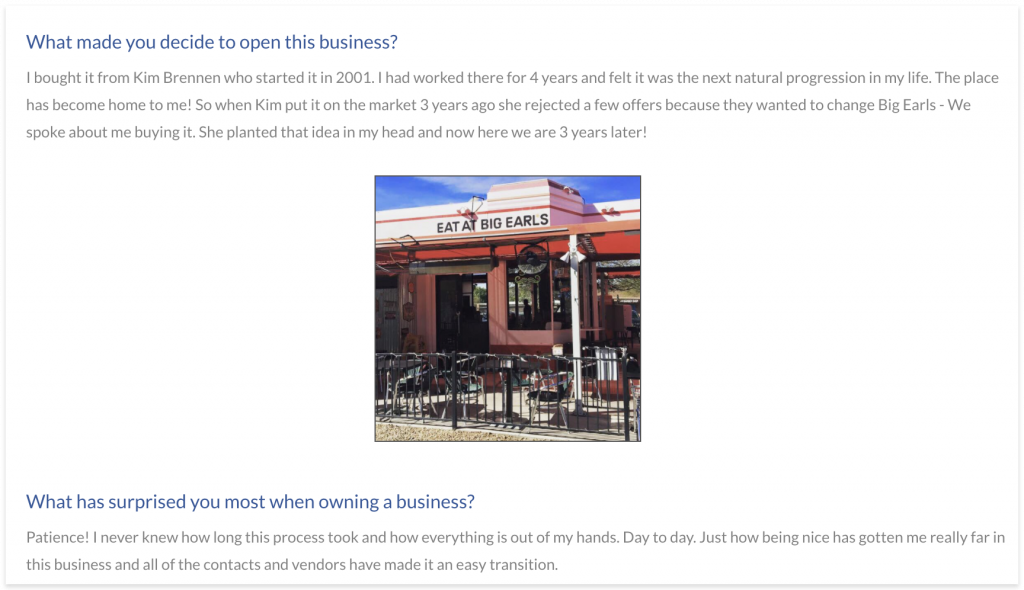Previously, we discussed tips for conducting a killer prospect interview.
Now that you’ve conducted your interview, we’ll share some tips on choosing a format for publishing your blog article!
There are 3 simple goals to keep in mind for writing your interview post:
- Make it informative for readers.
- Make it useful to the business owner.
- Keep it positive and sincere.
4 Key Prospect Interview Criteria To Keep In Mind
Length
Unless you’re aiming for the Pulitzer Prize in journalism, shorter is better. 400 – 600 words is a long read from a mobile phone. The typical screen displays approximately 100 words at a time, so a 500wd interview will feel more like 5 pages to an online reader.
SEO
Keywords: The most important keyword is the business name. Try to include the business name at least 5x in the article. Anyone searching the business locally by smartphone or desktop is more likely to find it. Include the business name in the title of your article, and 1 sub heading. Publish the business address as well.
Images
Choose your best image at the highest resolution. Add an ‘alt text’ description to boost your image SEO, which will help search engines and persons using voice search to find your content.
Content
Your content, or copy, should be focused on your subject, informative to readers, and objective. Avoid sharing your personal opinions on topics such as religion, race, or gender. Be sensitive to your readers as well as your audience by using appropriate terms, where relevant.
Organize your content in a logical order so that the flow of your ideas develops naturally. Start at the beginning, then the middle, and summarize your content in a brief conclusion. Use subheadings for each paragraph that summarize the key points.
If you plan on referring to statistics or current affairs, always cite the source using a hyperlink.
Prospect Interview Formats
After reviewing your notes, you’ll want to choose a style for the article. There are two interview styles common among journalists: feature narrative, and Q&A.
#1) Feature Narrative Style
Great for: Realtors with strong writing skills.
Estimated time: 1.5- 2 hours
Length: 400 -600 words
You can tell the interview as if it were a feature story. Like any story, you need a plot or a logical progression of ideas: establish a setting, the characters, and then document your experience.
Choose a starting point, then, proceed in a logical sequence to the end of the interview. Always start with a description of your setting. Describe what you see, hear and feel with specifics. Search for adjectives that best convey the mood or atmosphere, and the personalities you interact with.
Your opening line is the most important part of the article. Make it captivating. Give the reader something unexpected. Start at the most interesting point of the interview. Describe what you see, hear and feel, instead of what you are thinking. Write the opening line last. Here’s a great example:
“It’s not exactly how I thought the day would go, but in the mid-afternoon in a warehouse building somewhere off the 101 freeway, Lorde is stripping down to her skivvies.” (Rolling Stone Magazine)
Of course, you’re not interviewing a rising pop star, but pay attention to the things you find striking, unique or different about your subject (i.e. habits, mannerisms, clothing), the location (busy, quiet, intimate, loud, bright, etc), or the interview in general.
Keep the article focused on the business owner. Use his or her words whenever possible, rather than your own – and don’t misquote! Since you can’t transcribe everything, choose 3 – 5 key points about your interviewee: Who, what, where, why, and how. For each point, see if you can sum up the answer in three sentences. This will help keep your article focused.
#2) Q & A Style
Perfect for realtors with moderate writing skills.
Estimated time: 1.5 – 2 hours
Length: 400 – 600 words
The question and answer format are quite common and fairly easy to do. The key is transcribing the interview, word for word.

example q&a style interview
Your opening for a Q&A article should be an introduction that explains who you are interviewing, why, and where the interview took place:
This interview was conducted in a house near Princeton University, where Atwood had gone to give some readings and lectures. In person, Atwood is much as one might expect from reading her work—incisive. For many hours over a period of two days, while teenage boys bounced basketballs and played music outside, people walked in and out, and football games played on the television in the next room, Atwood sat, attentive, answering each question without hesitation. She never strayed from her point, never seemed to tire, and remained, like a narrator from any one of her books, unflappable.(The Paris Review)
It can also be a brief description of your interviewee’s background and main achievements until present time:
Kevin Spacey acted on Broadway in the 1980s, hit it big in Hollywood in the 1990s, and then surprised everyone by moving to London to become the director of the Old Vic theater. In 2013 he returned to the screen, producing and starring in Netflix’s first streaming series, House of Cards. Why all the unconventional career moves? As he told a 2015 World Business Forum audience, “It’s the risk takers who are rewarded.” (Harvard Business Review)
The body of the article will read like a transcript. Typically, you should separate your questions from the interviewee’s responses:
Bob (realtor): So, how long has your restaurant been in the neighborhood?
Business Owner: I’ve been here over 25 years and I can’t imagine a better place to run a business!
You can also distinguish your lines from the interviewee by using italics.
Proofread Before You Publish Your Prospect Interview
Regardless of the style you choose, your final step will be proofreading. Grammarly is a web-based, automated proof reader that will edit your copy for you. Send a draft to your interviewee before you publish it to avoid any errors.
Check out a great example of a Parkbench Interview Article by Deborah Lonsdorf to get you started!
So there you have it! With practice, your articles will improve, and your clients will appreciate your effort. It’s worth the investment of your time to produce an article your prospect will actually want to share!
Stay tuned for more great advice on how to transcribe your article and promote it on social media!
Happy writing and have fun!






